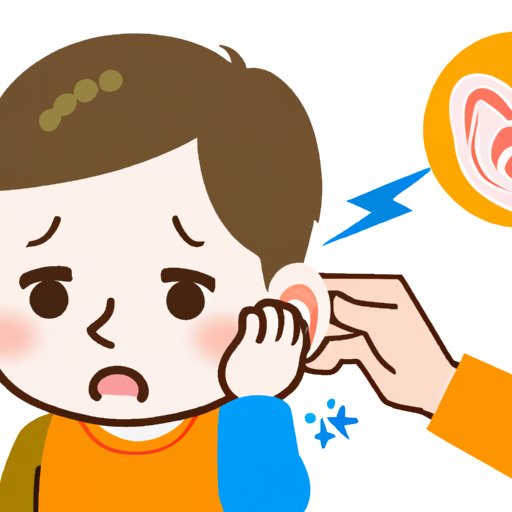
Introduction
Ear infections are common, and anyone can get them, regardless of age or gender. They can cause a lot of discomfort and pain, and if left untreated, they can lead to serious complications. This article will explore the symptoms of an ear infection and how to recognize them. We will cover the signs that can occur in both adults and children, as well as infants. By reading through this information, you will be able to identify the symptoms and seek medical attention if necessary.
Listen up! Recognizing the telltale signs of an ear infection
One of the most common symptoms of an ear infection is pain in the ear. The pain usually comes on suddenly and can be quite severe. It can vary in intensity from a mild ache to a sharp, stabbing pain. The pain may be constant or it may come and go. Adults and children can describe the pain as a feeling of pressure or fullness in the ear.
Another sign of an ear infection is a change in body temperature. A fever is a common symptom of an ear infection, particularly in children. The fever can range from mild to high grade, and it can be accompanied by other symptoms such as chills and sweating.
Hypersensitivity to sound or hearing loss is another sign of an ear infection. You may find that sounds you normally tolerate become intolerable or that you have difficulty hearing. In some cases, you may experience ringing in the ears or a feeling of fullness in the ear.
The agony of otitis: Symptoms to watch for in ear infections
Ear infections can cause symptoms that vary depending on the age of the person affected. Here are some symptoms to watch for:
Symptoms in children
In children, symptoms of an ear infection may include pulling or tugging at the ear, irritability, fussiness, crying, and difficulty sleeping. They may also have a persistent fever, reduced appetite, vomiting, and diarrhea.
Symptoms in adults
In adults, symptoms of an ear infection can include ear pain, hearing loss, dizziness, and a feeling of fullness in the ear. Adults may also experience drainage from the ear, a sore throat, and a fever.
Symptoms in infants
In infants, symptoms of an ear infection can include fever, irritability, difficulty sleeping, and reduced appetite. They may also have a yellow or bloody discharge from the ear.
Don’t let an ear infection go unnoticed: Identifying the early warning signs
It’s important to identify the early warning signs of an ear infection so that you can seek medical attention before the infection becomes severe. Here are some early warning signs to watch for:
Itching or discomfort around the ear
Before an ear infection becomes painful, you may experience itching or discomfort around the ear. This can be a sign that an infection is beginning to develop.
Fluid discharge from the ear
A discharge of fluid from the ear is a sign of an infection. The fluid may be clear, yellow, or even bloody in color, and it may have an unpleasant odor.
Sleeping difficulties and head tilting
Difficulty sleeping and head tilting are also early warning signs of an ear infection. If you notice that your child is having trouble sleeping or is tilting their head to one side, it may be a sign that they have an infection.
Ear infections 101: Spotting the symptoms in both adults and children
Ear infections can cause a range of symptoms in both adults and children. Here are some common symptoms to watch for:
Dizziness or lightheadedness
Feeling dizzy or lightheaded can be a sign of an ear infection. These symptoms may be accompanied by a feeling of unsteadiness or vertigo.
Nausea and vomiting
Some people may experience nausea and vomiting as a result of an ear infection. This can be particularly problematic in children who may struggle to keep down food or fluids.
Fever
Fever is a common symptom of an ear infection, particularly in children. The fever may come on suddenly and may be accompanied by other symptoms such as chills and sweating.
Putting an ear infection on blast: How to know when it’s time for a doctor’s visit
If you or your child is experiencing any of the symptoms listed above, it may be time to seek medical attention. Here are some signs that you should see a doctor:
Severe or persistent ear pain
If the pain in your ear is severe or it persists for more than a day or two, it’s time to see a doctor. Severe ear pain can be a sign of a serious infection or an injury to the ear.
Changes in hearing
If you notice a sudden change in your hearing, or if you feel like your hearing is muffled or reduced, it may be a sign of an ear infection. Seeing a doctor can help you identify the cause of the problem and get appropriate treatment.
High fever or excessive fluid discharge
If you or your child has a high fever or if there is excessive fluid discharge from the ear, it’s time to see a doctor. These symptoms can be a sign of a serious infection that requires medical attention.
Conclusion
Ear infections are a common but uncomfortable condition that can affect anyone at any age. Recognizing the symptoms of an ear infection is important so that you can seek medical attention if necessary. In this article, we covered the symptoms to watch for in both adults and children, as well as infants. If you are experiencing any of these symptoms, it’s important to seek medical attention to prevent complications.




